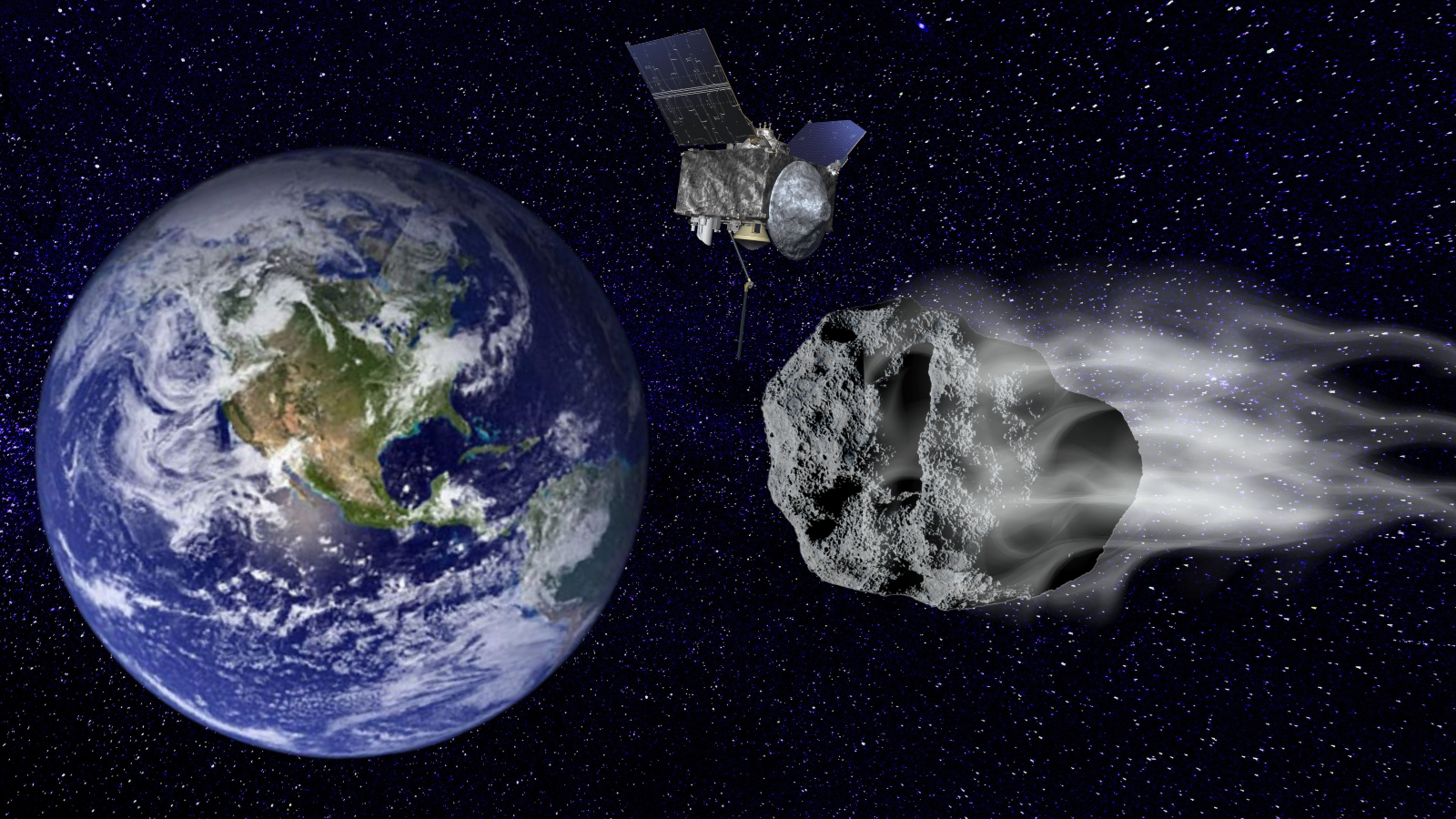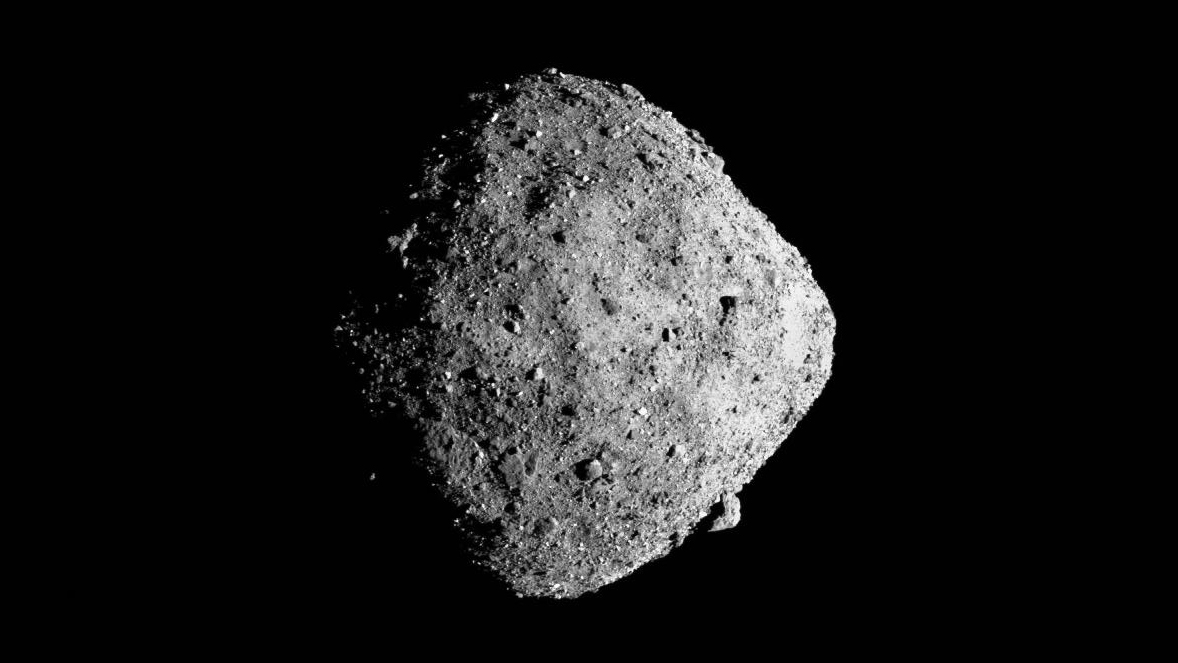NASA can't wait for its OSIRIS-APEX spacecraft to meet 'God of Chaos' asteroid Apophis in 2029
Apophis will make an asteroid flyby like no other in recorded history in 5 years as it becomes visible with the naked eye, and OSIRIS-APEX will be on hand to supervise.

NASA's asteroid sampling spacecraft OSRIS-APEX will have an exciting new mission in 2029, when it will watch an exciting asteroid encounter like no other in recorded human history.
The craft, formerly known as OSIRIS-REx, will bear witness as the asteroid Apophis— named after the ancient Egyptian god of chaos— comes so close to our planet that it could be visible with the naked eye in some parts of the world.
After bringing a sample back from asteroid Bennu, the craft was recently rebranded the Origins, Spectral Interpretation, Resource Identification, and Security – Apophis Explorer (OSRIS-APEX) in recognition of this "bonus mission."
The close approach of Apophis, which is thought to be 1,115 feet (340 meters) across almost as wide as the Empire State Building is tall, on April 13, 2029, will see the space rock come as close to Earth as 20,000 miles (32,000 kilometres), closer than some satellites.
"OSIRIS-APEX will study Apophis immediately after such a pass, allowing us to see how its surface changes by interacting with Earth’s gravity," OSIRIS-APEX project scientist Amy Simon said in a statement.
Related: Asteroid Apophis will visit Earth in 2029. Why do scientists want NASA to send a probe there first?
Apophis became notorious in 2004 as an asteroid that could potentially impact Earth with a size great enough to pose a threat to our planet. However, in March 2021, observations of the orbit of the space rock, also known as Asteroid 99942, led astronomers to conclude that it poses no threat to Earth for at least 100 years.
NASA scientists still want to know how the brush with Earth in 2029 will affect the 324-day orbit of Apophis around the sun. Additionally, coming close to Earth, which Apophis only does around once every 7,500 Earth years, may shake up the surface of the asteroid by triggering quakes and landslides.
Get the Space.com Newsletter
Breaking space news, the latest updates on rocket launches, skywatching events and more!
Though this sounds catastrophic, it could reveal what lies beneath the surface of Apophis, and OSIRIS-APEX will be on hand after the encounter to investigate any secrets that are revealed.

"The close approach is a great natural experiment," OSIRIS-APEX principal investigator and University of Arizona scientist Dani Mendoza DellaGiustina said. "We know that tidal forces and the accumulation of rubble pile material are foundational processes that could play a role in planet formation. They could inform how we got from debris in the early solar system to full-blown planets."
Because asteroids are composed of material left over from the formation of planets around the infant sun around 4.5 billion years ago, this investigation could reveal what the building blocks of Earth and its fellow rocky planets were.
Apophis is made of silicate materials and nickel-iron, making it considerably different from the carbon-rich asteroid Bennu, which OSRIS-APEX visited under its prior moniker in Oct. 2020 to collect a sample that it dropped off at Earth in September 2023 before continuing on its mission.
OSIRIS-APEX will reach Apophis shortly after the asteroid makes its closest approach of Earth on April 13, 2029, and will operate around the asteroid for approximately six months. During this time, the spacecraft will perform some of the same investigations that it did during its time at Bennu — analyzing the surface and chemical makeup of Apophis.
And just as it did at Bennu, OSIRIS-APEX will cap this investigation off by dropping to within around 16 feet (5 meters) of the surface of Apophis and blasting it with its thrusters, further displacing surface material to get closer to the heart of the Empire State Building sized space rock.
"We learned a lot at Bennu, but now we’re armed with even more questions for our next target," Simon concluded.
Update 1/3: NASA has clarified that, though Apophis makes its closest approach of Earth on April 13, 2029, OSIRIS-APEX will only arrive at its target shortly thereafter. This article has been updated to reflect this.
Join our Space Forums to keep talking space on the latest missions, night sky and more! And if you have a news tip, correction or comment, let us know at: community@space.com.

Robert Lea is a science journalist in the U.K. whose articles have been published in Physics World, New Scientist, Astronomy Magazine, All About Space, Newsweek and ZME Science. He also writes about science communication for Elsevier and the European Journal of Physics. Rob holds a bachelor of science degree in physics and astronomy from the U.K.’s Open University. Follow him on Twitter @sciencef1rst.
-
Unclear Engineer I found this for locations where it will be visible as it passes https://www.space.com/nasa-asteroid-apophis-approach-earth .Reply
Is there something more specific about time and direction for specific places on Earth?
And, since it is scheduled to fly-by on Friday the 13th, in April 2029, I am already imaging the tin foil hat sales will skyrocket in early 2029. (Probably not a good investment opportunity, though.) -
Unclear Engineer Bill Slugg posted :Reply
"NASA says it will be visible in the Eastern Hemisphere, from Eastern Europe all the way over to Australia." I can see that in my e-mail, but it doesn't show up here. So, maybe it has been deleted.
Anyway, that doesn't seem to match the video in the link that I posted, which shows a red track (with a gray section for closest approach) that goes farther west - over the Atlantic and the U.S. eastern coastal areas in darkness, but then gets into daylight as it goes farther westward.
It would be nice to have something like the maps currently being produced for the next total solar eclipse that shows the path of the shadow as a function of time, with specified % of totality off to the side.
Yes, there is no shadow from Apophis - it would be different parameters on the map. Probably something like time of maximum angle above the horizon and what that angle is, as a function of position on the map. -
billslugg So typical of SDC, they tout a video and then give you three black boxes, none of which are labelled, some of which turn out to be videos, none tell you how long you have to sit there and waste your life waiting, some have two ads in sequence, none tell you what it is you are waiting for. Some just end with nothing following. Some repeat the same ad. I gave up. I'll wait for the newspaper article in 2029, it will be straightforward.Reply -
Unclear Engineer By 2029, there probably won't be any newspapers left.Reply
When I click on the link I provided in my post, I get a Space.com web article with 3 graphics boxes, the second of which is the video I am referring to. I first appears with the graphic from the video, but if you don't click on it fast enough, it becomes a black box. When I do click on it, I get one ad and then the video. -
billslugg WHAT! No more day old news written in carcinogenic ink on ground up trees and thrown into my bushes?Reply
What happens is, the second square needs some time to load, I look at it for two or three seconds, don't see any label, see no progress being made, tab down a bit. As soon as it is up off the screen, it reappears in miniature at the lower right side of the screen amidst the advertisements where it goes unnoticed. In their attempt to bully you into watching it, they put it out in the trash where it goes unseen.
I did watch it, and it is not clear if we can see it or not from the Eastern US. It seems to be right at sunset for us and is low in the eastern sky. I also can't tell if it is in sunlight or not.









